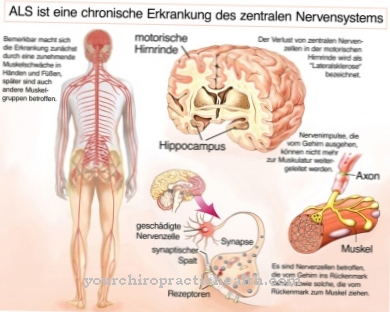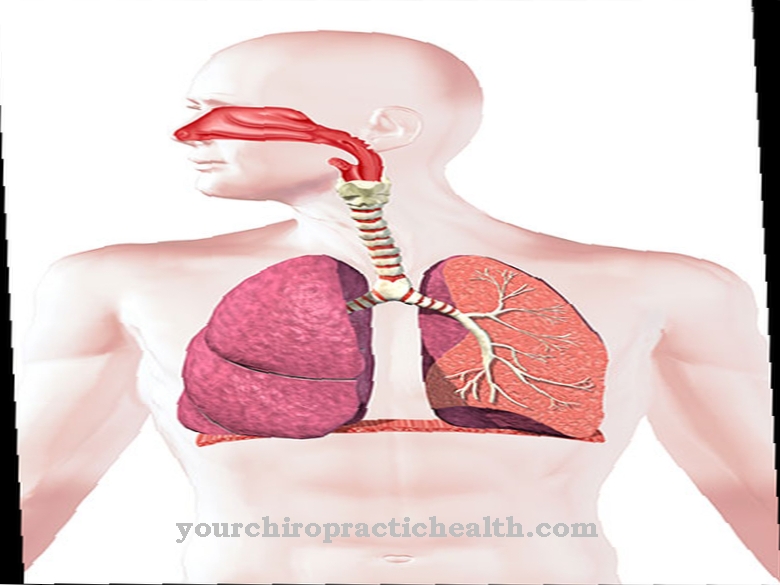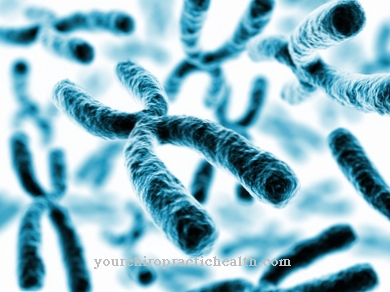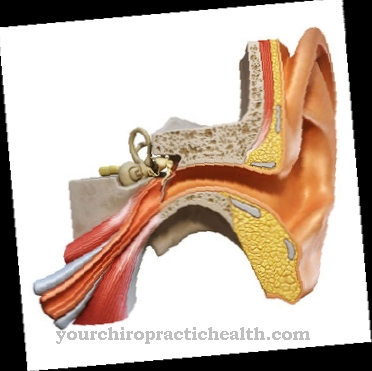Under the concept Osteopetrosis the doctor describes a hereditary disease, the exact cause of which is still unknown today. A breakdown of the bone is characteristic of osteopetrosis. The disruption of bone resorption subsequently leads to a pathological accumulation of the bone matrix. Osteopetrosis is hardly curable; there is also no special therapy that specifically treats the cause, so that only symptom-related treatment is given.
What is osteopetrosis?

© Natis - stock.adobe.com
The Osteopetrosis, also known as Marble Bone Disease, Osteopetrosis, Alberts Schönberg disease, is usually inherited. There is also the possibility of a spontaneous mutation, so that direct inheritance did not take place, but the affected person can very well pass on the osteopetrosis.
Due to the hereditary hypofunction of the osteoclasts (these are the bone-degrading cells), the genetic disease arises. If the doctor has diagnosed osteopetrosis, it is divided into two main groups:
- There are the autosomal dominant forms of type 1 (ADOI) and type 2 (ADOII, also known as Albers-Schönberg disease)
- As well as the autosomal recessive forms (osteopetrosis with renal tubular acidosis, infantile malignant osteopetrosis).
For the course of further treatments and also the prognosis, it is essential that the doctor divides osteopetrosis into its type.
causes
The causes of the gene mutation are so far unclear; However, medical professionals have found out which defects are present in which areas. Thus, in the context of autosomal recessive osteopetrosis, the positions TCIRGI1, OSTM1, SNX10 and / or CLCN7 in the osteoclast-rich forms and the positions TNFRSF11A (RANK) and / or TNFSF11 (RANKL) in the osteoclast-poor forms.
If there is an autosomal recessive osteopetrosis with renal tubular acidosis, it is a change to CAII, if an autosomal dominant osteopetrosis (type 1) is a change to LRP5, and if type 2 is a mutation to CLCN 7.
Symptoms, ailments & signs
As the medullary spaces shrink and then extramedullary blood formation occurs, the microarchitecture in the bone is destroyed. The destruction subsequently leads to bone instability, so that those affected carry an increased risk of suffering fractures. Furthermore, the constant build-up of the bone matrix, with no degradation activities taking place, leads to hypocalcemia.
Due to the matrix proliferation, there is also constriction in the skull bone, so that the optic nerves (in the optic canal area) are pinched. The compression sometimes leads to degeneration of the nerves, so that the affected person can go blind. In some cases, pinched cranial nerves have also been reported (e.g. vestibulocochlear nerve, facial nerve), so that the affected person suffered from functional failures.
However, blindness and dysfunction are among the rare symptoms of osteopetrosis; The focus is on the problem of bone stability and the associated frequency of fractures.
Diagnosis & course of disease
Osteopetrosis can be diagnosed using imaging methods (such as an X-ray) - in combination with the clinical picture. A bone punch biopsy is recommended so that any bone marrow sclerosis can be confirmed. The doctor not only recognizes sclerosis of the bone matrix on the X-ray images, but also a strong compression of the same.
This is the so-called "sandwich vertebra", a 3-layered structure of the vertebral bodies. You can also see metaphyseal and diaphyseal stripes, which were also responsible for the formation of the term “marble bone”. The bone density is also increased on the CT. Blood tests usually show pronounced hypocalcaemia.
Because of the bony replacement that forms in the bone marrow, there is an increased susceptibility to infection or anemia can occur. In the context of the diagnosis, however, the doctor must be able to rule out other diseases; these include melorheostosis, sclerostosis, pycnodysostosis, Engelmann syndrome (also known as progressive diaphyseal dysplasia) and Pyle syndrome.All of these diseases show a similar clinical picture.
The course of autosomal dominant or recessive osteopetrosis is different. The autosomal recessive osteopetrosis manifests itself already in the first years of life of the person affected. The first symptoms can be seen just a few weeks after the birth. If autosomal recessive osteopetrosis is not treated, the prognosis is negative. There is only a chance of recovery in the context of a bone marrow transplant.
In type I of autosomal dominant osteopetrosis, the main focus is on the base of the skull, while in type II the "sandwich vertebrae" are characteristic. Both forms cause the first symptoms as part of the growth spurt. Causal treatments are not available for types I and II, so symptoms are primarily treated. This means that - as with autosomal recessive osteopetrosis - there is no definite chance of recovery.
Complications
As a result of osteopetrosis, the main risk of fractures and broken bones increases. Due to the extramedullary (“located outside the marrow”) blood formation, there is increased liver and spleen enlargement, reduced immune defense, seizures and nerve damage. The latter mainly affect the cranial nerves and can subsequently lead to blindness and other symptoms of failure.
In individual cases, osteopetrosis can damage the lower jaw and the periodontium. In addition, there are cosmetic problems that can lead to psychological complaints over time. In severe cases, osteopetrosis is fatal. The drug treatment of osteopetrosis can lead to a number of side effects and interactions. Vitamin D supplements can cause nausea and vomiting as well as muscle weakness and joint pain.
The active ingredient glucocorticoid can lead to growth disorders, glaucoma, cataracts and psychological changes such as sleep disorders and restlessness. There are also risks associated with the frequently used bone marrow transplantation. Complications such as the rejection of the bone marrow from the recipient organism often arise during the surgical procedure. This can lead to skin, liver and intestinal damage, which sometimes exacerbates the original osteopetrosis.
When should you go to the doctor?
If you repeatedly suffer fractures or suddenly notice visual problems, you should consult your family doctor. The symptoms indicate osteopetrosis, which must be diagnosed by a specialist. If there is any suspicion, it is best to go to the orthopedic surgeon. Medical advice is required if the symptoms arise in connection with other malformations or bone diseases.
Since it is a hereditary condition, genetic testing can identify the condition in the early stages. Parents should consult the pediatrician in the event of functional disorders of the child's musculoskeletal system. The ophthalmologist must be consulted if there are problems with the eyes. Physiotherapists and sports medicine specialists are also involved during treatment and support the patient over a long period of time.
Parents should consult their doctors during therapy. If the child falls or is otherwise injured, the emergency services should be called. In the event of severe complaints, the emergency medical service must also be contacted so that the child can be helped immediately after the fall. After the first aid by the emergency doctor, the patient must be examined in the hospital. Any fractures or sprains are diagnosed and treated there. Osteopetrosis can be treated relatively well, but the high risk of fractures can repeatedly lead to serious injuries that require treatment.
Treatment & Therapy
There is no causal therapy for osteopetrosis. For this reason, the doctor must treat the patient's symptoms and thus ensure that the quality of life can be increased. As part of the treatment, glucocorticoids and interferons are administered to improve symptoms and symptoms.
The only really effective therapy is based on bone marrow transplantation. With this variant there is the possibility that the osteoclasts, due to the hematopoietic stem cells, normalize. However, bone marrow transplantation is only possible with autosomal recessive osteopetrosis; all other types have no definite chances of recovery, so the therapy aims to alleviate the symptoms and discomfort and to improve the quality of life of the person affected.
Outlook & forecast
In the case of marble bone disease or osteopetrosis, the prospects for a cure are usually poor. This diagnosis is especially true if the condition is left untreated. In most cases there is a hereditary hypofunction of the so-called osteoclasts. This then ensures unregulated bone formation.
So far the only treatment option is a bone marrow transplant. Only then can sufficient osteoclasts form again. Osteoclasts are cells that break down bone. However, the transplant carries high risks, namely calcemia as a result.
There are differences in the course of the disease in the autosomal recessive and the autosomal dominant form of the disease. Autosomal recessive osteopetrosis most often develops in early childhood. Sometimes it also arises after birth as infantile malignant osteopetrosis. Mild clinical pictures are also known. These can overlap with the dominant osteopetrosis. Without symptomatic treatment and a bone marrow transplant, the outlook is bleak.
The autosomal dominant osteopetrosis (ADOI) is usually a generalized osteosclerosis of the skull base, or as an Albers-Schönberg variant (ADOII) with "sandwich vertebrae". This form of disease only manifests itself in adolescence. The course forms of both are different. With one variant, the bones become more and more stable. With the other, they break more easily. It can also lead to complications. There is currently no more than symptomatic therapy.
prevention
Due to the fact that so far no causes have been found for what reason osteopetrosis occurs, preventive measures are not possible.
Aftercare
In most cases of osteopetrosis, patients have very few and limited measures available for direct follow-up care. First and foremost, a quick and, above all, early diagnosis of the disease should be made so that there are no complications or other complaints in the further course. The earlier a doctor is consulted, the better the further course of the disease is usually, so that a doctor should be contacted as soon as the first signs and symptoms appear.
Most patients with osteopetrosis depend on the intake of various medications. The correct dosage and regular intake of the medication must always be observed in order to permanently limit the symptoms. Furthermore, the person concerned should contact a doctor if there are side effects or if anything is unclear.
Sometimes psychological support can be helpful, which can prevent the development of depression in particular. The support of those affected in their everyday life is also very important in order to improve their quality of life. In some cases, osteopetrosis also reduces the sufferer's quality of life.
You can do that yourself
In the case of osteopetrosis, the most important self-help measure is to regularly perform the physical exercises recommended by your doctor and otherwise to spare the affected bones. Comprehensive physiotherapy can at least slow the progression of the disease. Exercise also improves well-being and thus contributes to an improvement in the quality of life. Affected people should also change their diet. It is advisable to avoid foods with too much salt, as these can lead to an increase in osteoclasts.
Rest after a bone marrow transplant. The osteopetrosis patient should not exert themselves for one to two weeks and should also refrain from strenuous physical activity for the time being. If this does not alleviate the symptoms, a further visit to the doctor is recommended.
Patients can also speak to an alternative health professional about alternative treatment. Both massages and acupuncture are discussed as effective accompanying measures for osteopetrosis. In the case of the condition, which steps are sensible depends largely on the course of the disease and the accompanying circumstances. Therefore, the accompanying measures, like the therapy itself, should be discussed with the responsible orthopedic surgeon.

-durch-vitamin-b12-mangel.jpg)






















.jpg)



